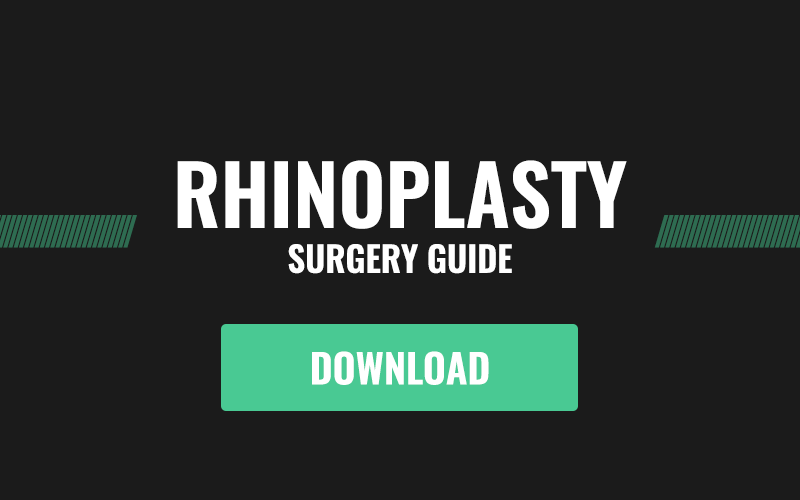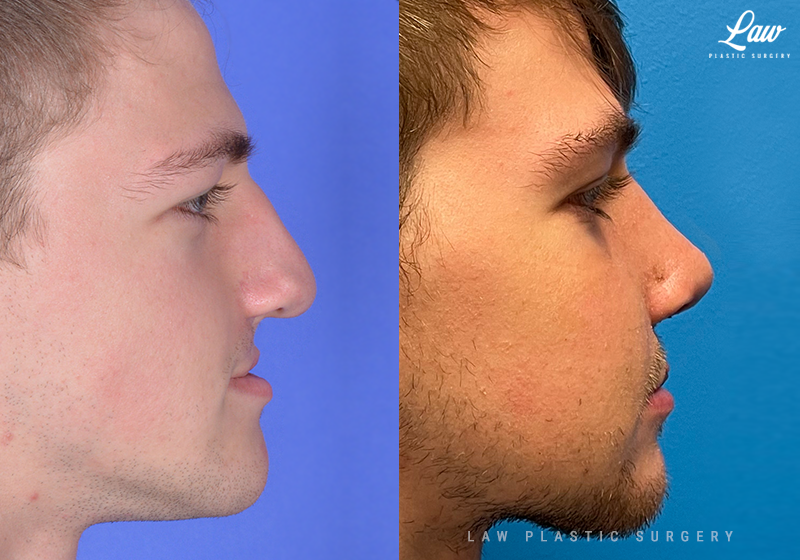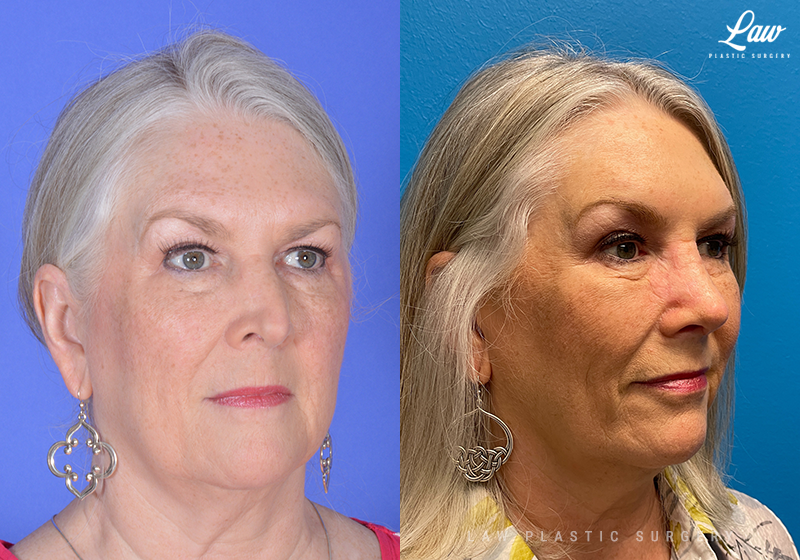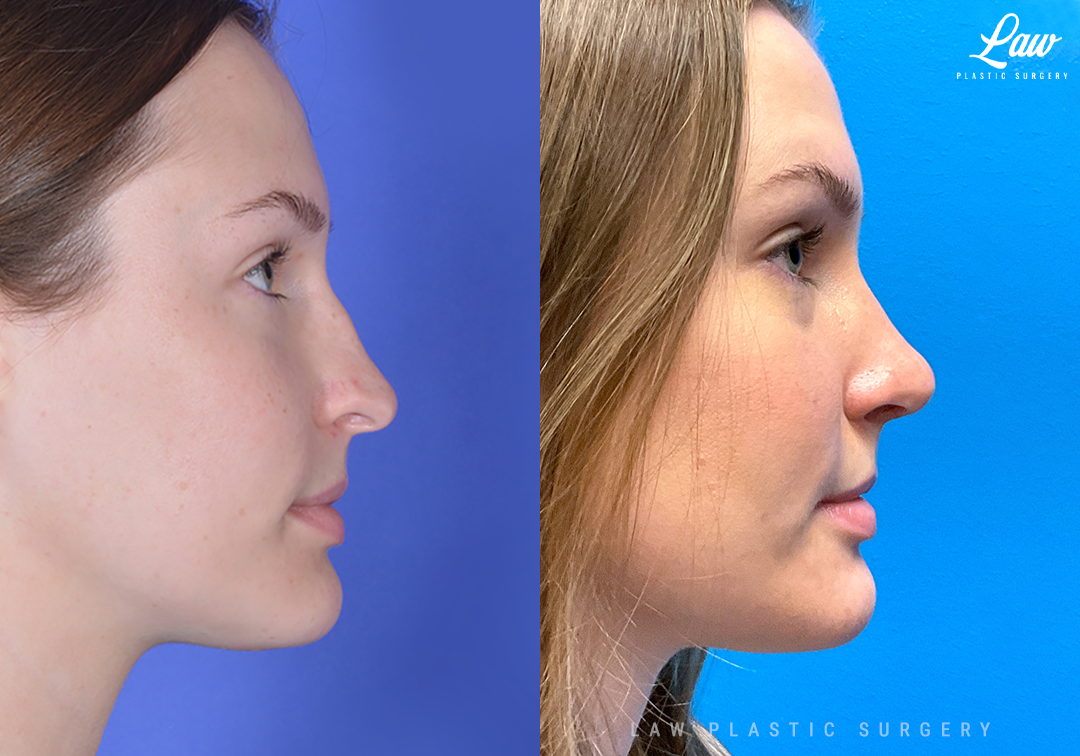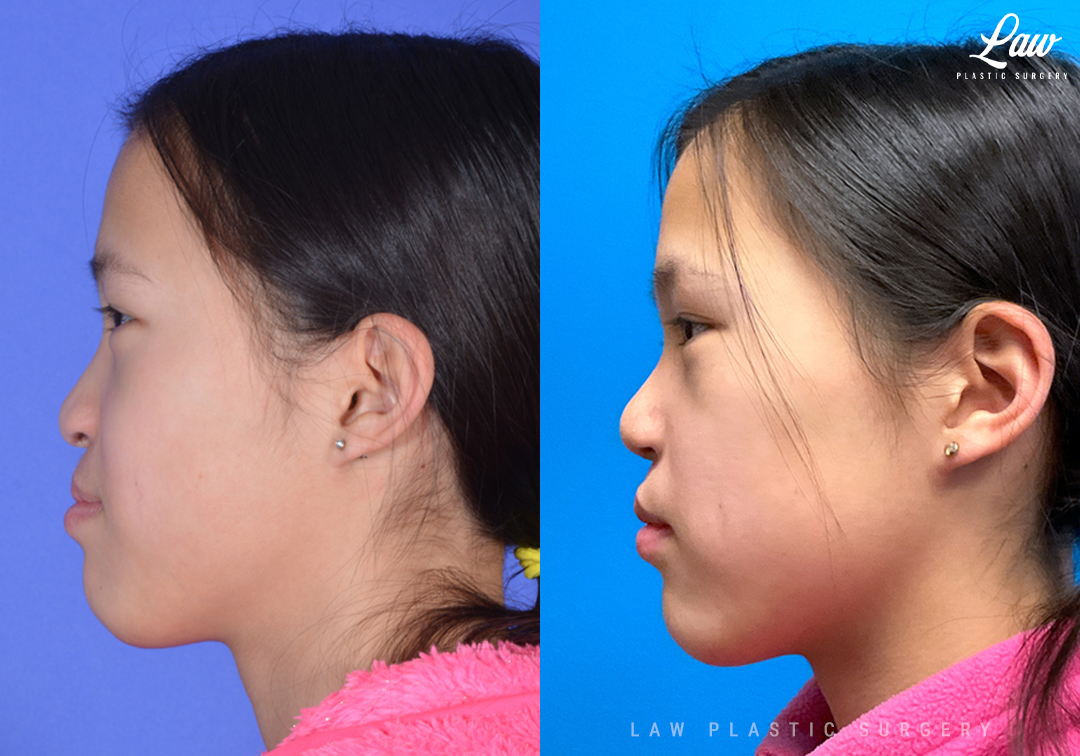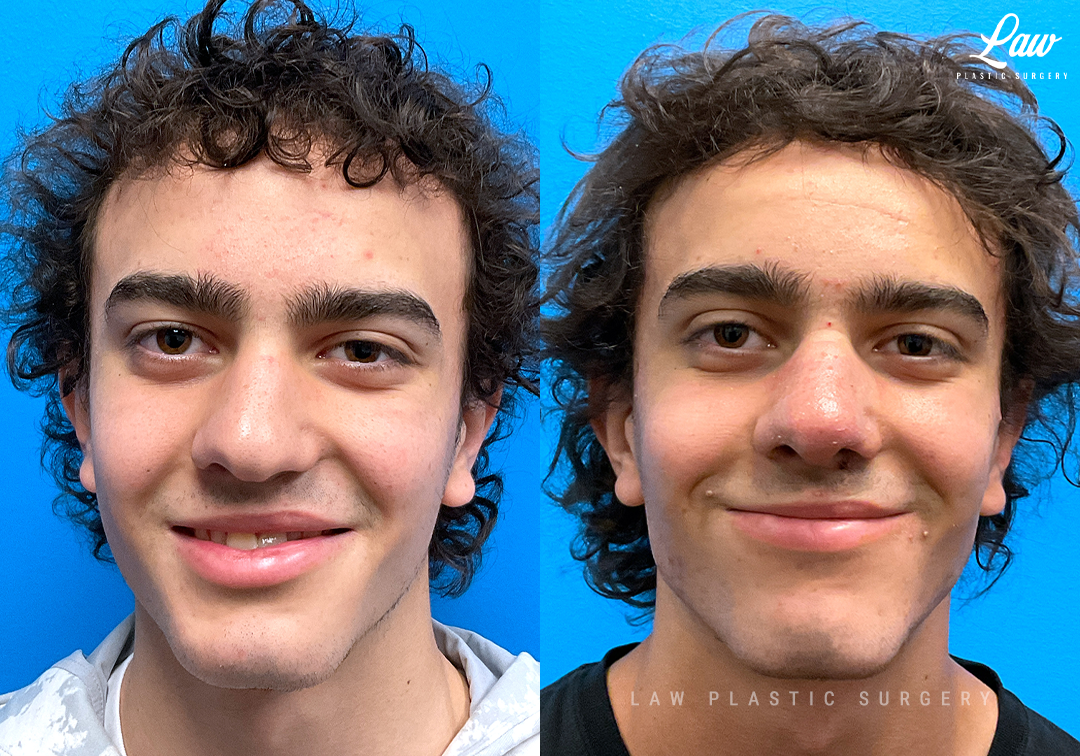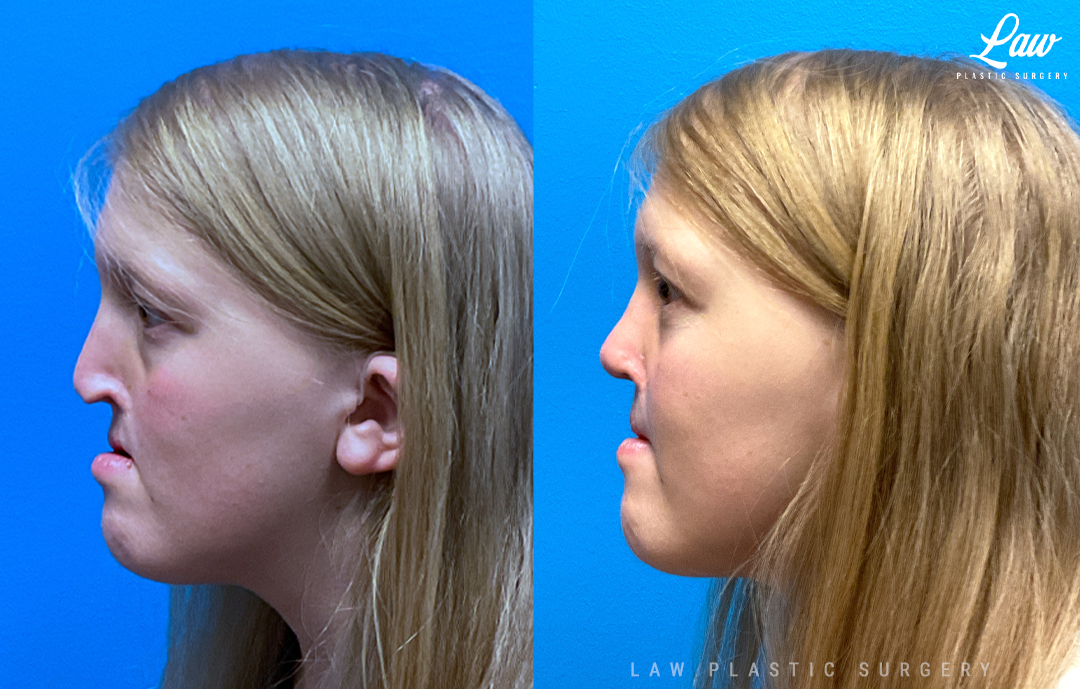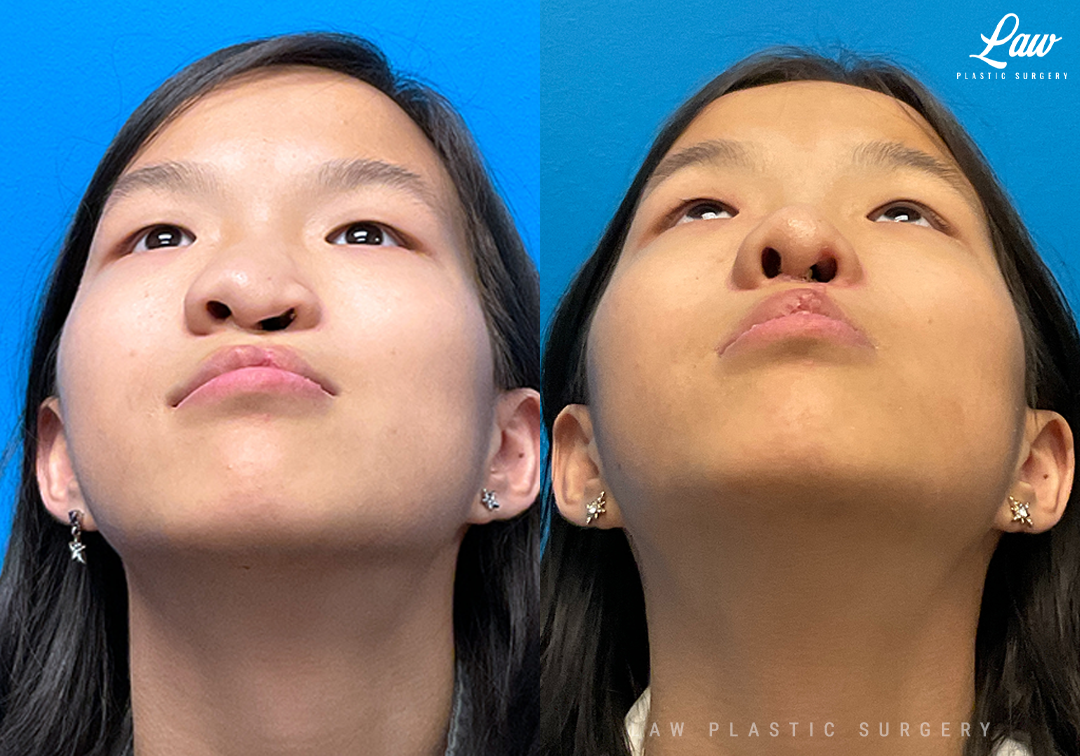Rhinoplasty FAQs Answered By Dr. Law
Rhinoplasty in Dallas
Rhinoplasty (nose surgery) is one of the most frequently performed plastic surgery procedures. During rhinoplasty, the nose is reshaped, reduced or augmented to improve its appearance. Rhinoplasty may be performed to correct a birth defect, or repair an injury such as a broken nose. It is also often performed strictly for cosmetic reasons.
For a patient with ongoing sinusitis, rhinoplasty is sometimes performed in conjunction with endoscopic sinus surgery; for a patient with a deviated septum, it is often performed along with septoplasty, a procedure that corrects a deviated septum. In such cases, rhinoplasty effectively treats health and breathing problems, in addition to improving the patient‘s appearance.
Candidates for Rhinoplasty
Candidates for rhinoplasty have finished their facial growth. Girls should typically be at least 15 or 16 years old; boys should be at least 17 or 18. Patients considering rhinoplasty should be in overall good health and not smoke. It is important that candidates have realistic expectations about what rhinoplasty can do. Although undergoing rhinoplasty may boost self-confidence, it should not be viewed as a cure-all for personality or relationship issues, and should not be the result of social pressure.
Goals of Rhinoplasty
There are several goals of rhinoplasty; they include facilitating breathing as well as improving appearance. During rhinoplasty, the surgeon may attempt to do one or more of the following:
- Remove a hump
- Modify the bridge
- Reshape the tip
- Reshape or resize the nostrils
- Repair an injury
- Open breathing passages
- Increase or decrease size
Rhinoplasty can involve modifying bone, skin or cartilage, or all three.
Rhinoplasty Before & Afters Photos
Click the image below to view more before and after photos.
The Rhinoplasty Procedure
Rhinoplasty, which typically takes from 1 to 3 hours, is usually an outpatient procedure performed under IV sedation or general anesthesia. Two techniques are typically used. In closed rhinoplasty, incisions are made within the nostrils. In open rhinoplasty, an incision is made across the columella, the tissue between the nostrils. With both methods, the soft tissues covering the nose are gently lifted, and the bone and cartilage are sculpted to the desired shape.
If additional cartilage is needed to augment the nose, it is frequently taken from the patient‘s nasal septum. If larger sections of tissue are required, cartilage may be surgically removed from the ear or other parts of the body as well. If the patient has a deviated septum, the septum and inner structures of the nose are adjusted to improve breathing. The tissues are then redraped and stitched closed. If necessary, nostrils are reshaped in the final stage of rhinoplasty.
Recovery from Rhinoplasty
Immediately after surgery, the patient‘s nose and eye area are usually bruised and swollen. Splints and nasal packing remain in the nose for a few days. During this period, the patient may experience some nasal pain or a dull headache, as well as some bleeding and drainage from the nose. Most patients feel like themselves within a few days and are able to return to work and regular activities in about a week. Return to strenuous exercise and activities typically is at 4 to 6 weeks after the operation.
To increase comfort, and decrease bleeding and swelling, rhinoplasty patients are advised to follow these post-surgical directives:
- Avoid strenuous activities
- Take baths instead of showers
- Avoid blowing the nose
- Avoid becoming constipated
- Avoid exaggerated facial expressions
- Brush the teeth gently
- Avoid pulling clothing over the head
- Use sunscreen that has an SPF of 30 or higher
- Limit dietary sodium
- Do not use ice packs
Although the patient usually looks “normal” a week or two after surgery, some swelling may be present for as much as a year.
Risks of Rhinoplasty
Complications associated with rhinoplasty are rare and, when they occur, usually minor. Surgical risks in general include infection or adverse reaction to anesthesia. In the case of rhinoplasty, specific risks include the following:
- Recurring nosebleeds
- Difficulty breathing through the nose
- Permanent numbness in or around the nose
- Persistent pain
- Discoloration of skin on the nose
- Scarring
- Perforation of the nasal septum
It is possible that a patient is not satisfied with the results of the rhinoplasty. In such a case, a second surgery, called a revision rhinoplasty, may be performed at a later date.
Rhinoplasty Before & Afters Photos
Click the image below to view more before and after photos.
Dallas Rhinoplasty (Nose Job) Specialist
A rhinoplasty is a plastic surgery procedure designed to change the visual characteristics of the nose. Other names for this procedure include nose-reshaping surgery and a nose job. Once an individual makes the decision to have a rhinoplasty, the most important factor is choosing a qualified plastic surgeon. The surgeon’s skill, knowledge and experience are all critical aspects of attaining optimal results. For this reason, many individuals choose to have Dr. Huay-Zong Law, who is a top plastic surgeon in Dallas specializing in nose reshaping and reconstruction procedures, perform their surgery.
Why Would Someone Choose to Have a Rhinoplasty in Dallas?
During a nose-reshaping procedure, Dr. Law can address aesthetic issues related to the cartilage, bone and skin of the nose. Therefore, somebody may choose to have a Dallas rhinoplasty to change the shape, size or proportions of their nose. In addition, when difficulty breathing is present, there are certain issues that Dr. Huay-Zong Law can address with just nose-reshaping surgery. However, if the patient’s breathing issues result from a deviated septum, Dr. Law will also need to perform a septoplasty. This combination procedure is referred to as a septorhinoplasty.
Benefits of a Dallas Rhinoplasty at Law Plastic Surgery
Nose-reshaping surgery is an outpatient procedure that can be used to make changes to the shape of the nose, as well as to improve some issues that negatively affect an individual’s ability to breathe. During a nose-reshaping procedure, Dr. Huay-Zong Law balances the patient’s facial features. Following recovery, many patients experience a boost in their self-confidence level.
A Combination Rhinoplasty and Septoplasty (i.e., Septorhinoplasty)
During the nose-reshaping portion of the septorhinoplasty procedure, Dr. Law improves the appearance of the nose by modifying the nasal bones and cartilage, or by using tissue to add volume. He can also repair nasal fractures to restore the nose to its pre-injury appearance.
While performing the septoplasty portion of the septorhinoplasty procedure, Dr. Huay-Zong Law improves the patient’s ability to breathe by correcting a deviated septum. He removes any internal nasal obstructions that are making it difficult for the patient to breathe. He also stabilizes any structures that could be blocking the nasal passages.
What is a Deviated Septum?
The nasal septum is the bone and cartilage that divides the nasal cavities. A deviated septum refers to a crooked or significantly off-center nasal septum.
Common symptoms of a deviated septum include:
- Nosebleeds.
- Snoring.
- Nasal congestion.
- Headaches.
- Frequent sinus infections.
- Postnasal drip.
- Facial pain.
- Noticeably loud breathing.
Rhinoplasty Before & Afters Photos
Click the image below to view more before and after photos.
What Causes a Deviated Septum?
A deviated septum can develop following an injury to the nose, or an individual can inherit a deviated septum.
Is There a Specific Age or Age Range That Plastic Surgeons Recommend for Dallas Rhinoplasty Procedures?
Individuals need to wait until their facial features have matured, which is why female nose-reshaping surgery patients must be at least 15 years old and male rhinoplasty patients must be at least 17 years old.
On the other hand, waiting too long can negatively affect the patient’s results, as well as lengthen his or her recovery time. Since safety risks increase with age, older patients may need to have a variety of medical tests. Furthermore, older patients need to provide the surgeon with a highly detailed medical history. For these reasons, plastic surgeons recommend that individuals have nose-reshaping surgery in Dallas before they reach the age of 40.
A Personalized Nose-Reshaping Procedure at Law Plastic Surgery in Dallas
The upper section of the nose consists of bone and the lower section is cartilage. While performing a rhinoplasty, Dr. Law can make changes to the cartilage, bone, skin or to all three. At the initial consultation, Dr. Huay-Zong Law asks the patient what he or she would like to accomplish. The goals of the patient determine the steps that Dr. Law uses during surgery, which is why each patient receives a custom-designed nose-reshaping treatment plan.
While creating each personalized treatment plan, Dr. Huay-Zong Law considers the patient’s other facial features, the skin on his or her nose, as well as what issues the patient would like him to address.
Rhinoplasty Before & Afters Photos
Click the image below to view more before and after photos.
What to Expect at the Initial Consultation for a Rhinoplasty in Dallas
During this initial consultation, Dr. Law asks the patient about his or her medical history. Patients should be prepared to provide information related to previous surgeries, current medications (prescription and non-prescription), herbal supplement and vitamin usage, chronic conditions and, if applicable, previous nasal obstructions or nose injuries.
Some patients find it helpful to bring in photos that represent the results they desire. The references help Dr. Huay-Zong Law as he creates the patient’s surgical plan.
After reviewing the medical information the patient provides, Dr. Law wants to know what the patient would like to accomplish with a nose-reshaping procedure. In addition, he wants to know if the patient is having any problems breathing out of his or her nasal passages.
Once Dr. Huay-Zong Law knows the reason that the patient wants to have a rhinoplasty at Law Plastic Surgery in Dallas, he examines the patient’s facial features. During this facial examination, Dr. Law examines the inside and the outside of the patient’s nose.
What Does the Facial Examination Accomplish?
This examination allows Dr. Huay-Zong Law to determine how the physical features of the patient’s nose could affect his or her results. Features he considers include the thickness of the skin, as well as how strong the cartilage at the tip of the patient’s nose is. Furthermore, this examination helps Dr. Law determine if there are nasal issues negatively affecting the patient’s ability to breathe freely.
Pre-Surgical Testing
Dr. Law may request that the patient have some presurgical testing done (e.g., blood tests, an EKG). Patients need to have these tests completed at least a week before their surgery. This allows time for Dr. Huay-Zong Law to receive and review the results.
Makeup-Free Presurgical Photographs
After completing the examination, if the patient is a good candidate for a rhinoplasty in Dallas, Dr. Huay-Zong Law or one of his medical assistants takes photographs of the patient’s facial features and nose from a variety of angles. Since the patient needs to be fresh-faced for these photos, individuals wearing makeup must remove it before they take the photographs.
These photos help Dr. Law as he creates the patient’s personalized nose-shaping surgical plan. In addition, once recovery is complete, Dr. Huay-Zong Law likes using these photos for comparison purposes.
Rhinoplasty Before & Afters Photos
Click the image below to view more before and after photos.
Dr. Law May Recommend a Chin Augmentation
A small chin can create the illusion of a large nose. Therefore, if a patient has a small chin, Dr. Law may recommend that the patient have a chin augmentation during the same surgical session as the rhinoplasty. Addressing the nose and the chin issues simultaneously ensures that the surgery provides the patient with an appealing, well-balanced facial profile.
On the Day of Surgery, Patients Need to Have a Ride Home
Due to the medications patients receive during surgery, they cannot drive themselves home; therefore, patients must bring a driver with them on the day of any procedure requiring twilight sedation or general anesthesia. Patients who neglect to bring a driver with them will need to reschedule.
Can a Patient Use For-Hire Transportation Services After Surgery?
Law Plastic Surgery has a strict policy against patients using any for-hire transportation service (e.g., Uber, Lyft, a taxi, public transportation) after surgery.
The reason for this policy:
Most patients are vulnerable following surgical procedures, which could make them a target for unsavory characters. Dr. Huay-Zong Law and his medical staff take the safety of their patients very seriously, which is why they prohibit the use of for-hire transportation after receiving anesthesia.
Following Their Rhinoplasty, Patients Need Someone to Remain with Them for at Least 24 Hours
After nose-reshaping surgery, patients need someone to stay with them for at least 24 hours, but preferably 48 to 72. This individual must be an adult that the patient feels comfortable with and trusts completely.
What is An Asian Rhinoplasty?
An Asian rhinoplasty is a nose-reshaping procedure that concentrates on addressing the nose characteristics frequently associated with the Asian community (e.g., wide nasal tips and flat bridges). This type of nose-reshaping procedure requires the surgeon to have a special skill set. As an experienced Asian rhinoplasty plastic surgeon, Dr. Law addresses any unwanted Asian-related features while maintaining the unique ethnic characteristics the patient would like to preserve.
Preparing for Nose-Reshaping Surgery in Dallas
Most patients return to work or school in 10 days; therefore, patients need to request an adequate amount of time off school or work.
To ensure the patient’s safety and that he or she enjoys optimal results following nose-reshaping surgery, the patient must follow the recommendations below.
For at least four weeks before and four weeks after their Dallas rhinoplasty:
Patients must stop smoking and using any other product that contains nicotine. These products include chewing tobacco, e-cigarettes, cigars, pipe tobacco, traditional cigarettes and smoking cessation products (e.g., nicotine gum). Patients who continue using these products are more likely to experience complications as they recover. These complications result from the nicotine restricting the blood vessels by causing them to contract. Once restricted, it takes the blood longer to move through the circulatory system, which negatively affects the body’s ability to heal the wound resulting from surgery. Complications can include the onset of an infection, an open wound and skin necrosis (i.e., skin death).
Rhinoplasty Before & Afters Photos
Click the image below to view more before and after photos.
For the two weeks leading up to surgery and the two weeks after surgery:
Patients need to avoid taking medications, herbal supplements and vitamins that thin the blood. Medications to avoid include aspirin, ibuprofen and non-steroidal anti-inflammatory drugs (NSAIDs). Prescription medications must never be discontinued without first speaking with the physician who prescribes the medication or Dr. Huay-Zong Law. Herbal supplements to avoid include Ginger and St. John’s Wort. Vitamins to avoid include vitamin E.
Patients who need to take pain medication within the two weeks leading up to their surgery or during the first two weeks of recovery can safely take acetaminophen (aka Tylenol®).
For the 48 hours before and the 48 hours after surgery:
- Since alcohol tends to increase swelling, it must be avoided for at least two days before surgery and two days after.
- If a patient falls ill prior to the date of or on the day of surgery, the patient needs to call the office at (972) 331-1900 as soon as possible to reschedule.
- Before surgery, Dr. Law provides the patient with any prescriptions for pain or antibiotics he or she needs during recovery. The patient should fill these prescriptions in advance. Doing so allows the patient to head home directly following his or her rhinoplasty in Dallas.
Fasting Before Surgery
For at least six hours before their Dallas rhinoplasty, patients must have nothing by mouth. This includes water, chewing gum and hard candy. If there is anything in the stomach during surgery, the patient’s risk of a complication related to the anesthesia increases. Patients who usually take medication during this six-hour period need to ask Dr. Huay-Zong Law if they can still take it with a small sip of water.
Nose-Reshaping Surgery in Dallas — What to Expect on the Day of Surgery
Patients need to arrive at least 15 minutes before their scheduled surgery.
A patient who arrives without a driver cannot have surgery and, therefore, will need to reschedule.
The patient must wear comfortable clothing that is loose fitting. In addition, the clothing must not require the patient to pull it over his or her head.
Patients should arrive with a clean face that is free of lotion and makeup.
All valuables need to remain at home.
Unless instructed to do so by Dr. Law, do not take any medications.
Once the patient is in the pre-op area, an intravenous fusion line (IV) is placed. For relaxation purposes, the patient may receive medication. Dr. Huay-Zong Law may visit the patient to create markings on his or her nose. Dr. Law uses these markings as a guide during the nose-reshaping procedure.
Rhinoplasty Before & Afters Photos
Click the image below to view more before and after photos.
What Patients Can Expect During a Dallas Rhinoplasty Procedure
Each nose-reshaping procedure is unique and customized for a particular patient; therefore, Dr. Law does not have a specific order of steps to follow. However, a general overview of a nose-reshaping procedure in Dallas can be found below.
A Dallas rhinoplasty can take from one to three hours. Patients who choose to have multiple procedures during a single session (e.g., a chin augmentation, septoplasty) should expect to spend more time in surgery.
Anesthesia
A rhinoplasty requires either general anesthesia, which places the patient in a deep sleep, or local anesthesia with sedation (aka twilight anesthesia). When Dr. Huay-Zong Law uses twilight anesthesia, the patient remains in a light sleep-like state during the procedure and awakens rather quickly once the nose-reshaping procedure is complete.
What Determines the Type of Anesthesia a Patient Receives?
The complexity of the surgery determines whether a patient receives twilight or general anesthesia.
Dr. Huay-Zong Law Performs Open and Closed Nose-Reshaping Procedures
The approach that Dr. Law uses depends on the changes he plans to make.
During a closed rhinoplasty, Dr. Huay-Zong Law creates two tiny incisions inside each nostril. Since these incisions are internal, there is no visible scarring.
While performing an open nose-reshaping surgery, Dr. Law makes small incisions on the columella, which is the tissue between the nostrils at the base of the nose. He also creates tiny incisions inside each nostril. These incisions allow Dr. Huay-Zong Law to access all the underlying framework of the patient’s nose.
Procedure Specifics
During nose-reshaping surgery, Dr. Law considers the patient’s aesthetic goals and anatomy.
To reduce a nostril flare and restructure the nostrils, Dr. Huay-Zong Law may perform an alarplasty (aka alar trimming, nostril reduction, alar reduction surgery). During an alarplasty, Dr. Law removes a small wedge of tissue from the base of each nostril. Reducing the size of a bulbous or large nasal tip requires the removal of alar cartilage as well. After removing the cartilage, Dr. Huay-Zong Law uses sutures to narrow the tip of the nose.
Dr. Law may address a narrow bridge and remove a dorsal hump with an osteotomy. During an osteotomy, Dr. Huay-Zong Law removes a strip of cartilage and nasal bone before bringing the remaining cartilage and bones together.
When a patient wants a straighter bridge, or Dr. Law needs to rebuild the nasal tip, he may harvest cartilage from the ear, the ribs or from the middle, underside section of the nose.
Once reshaping is complete, Dr. Law closes the incisions using dissolvable stitches.
Dr. Huay-Zong Law uses a splint or cast to secure the patient’s nose. The patient wears the cast or splint for about a week. Dr. Law usually removes it at the patient’s follow-up appointment.
Directly Following Surgery: The Recovery Area
Following surgery, Dr. Huay-Zong Law’s medical staff monitors the patient until he or she awakens. Once the patient is fully awake, he or she can prepare to head home.
When Dr. Huay-Zong Law is satisfied with the patient’s progress, he will release the patient to his or her driver.
Before they leave the recovery area, patients receive information related to cleaning their nose and their surgical incisions, what to expect as they recover, as well as their restrictions. At this time, Dr. Law encourages his patients to ask questions. He wants each of his patients to leave the recovery area feeling confident and well-informed.
Rhinoplasty Before & Afters Photos
Click the image below to view more before and after photos.
A Dallas Rhinoplasty: The Recovery Process
Patients need not be alarmed if several of their sutures become visible a couple of days after their nose-reshaping procedure.
A few days after surgery, the inflammation increases. This is normal and it will subside.
The internal dressings that Dr. Law places during surgery remain in place for up to seven days. To protect the nose, the external splint also remains in place for about a week.
Patients need to rest. It is important that patients keep their head raised higher than their chest. Doing so reduces inflammation and bleeding. Patients should expect their nose to feel congested. This feeling of congestion may be due to the splints Dr. Huay-Zong Law placed inside the nose or from inflammation.
For several days after a rhinoplasty in Dallas, patients typically experience slight bleeding, as well as draining of mucus and old blood. Dr. Law usually places a small piece of gauze beneath the nose. This gauze serves as a drip pad. Dr. Huay-Zong Law uses tape to hold this drip pad in place, directly beneath the nose. Patients will need to change this drip pad periodically. While still in the recovery area, patients learn the proper procedure for changing their drip pad from Dr. Law or a member of his medical staff.
Temporary inflammation or discoloration of the eyelids may occur, this side effect can last up to three weeks.
Residual swelling in the nose can take up to a year to resolve.
To decrease the likelihood of a patient experiencing unnecessary bleeding and excessive inflammation, patients need to follow the restrictions listed below:
- Avoid showers, take baths instead, especially while the bandages are still present.
- Do not participate in strenuous activities (e.g., jogging, aerobics).
- Patients must avoid blowing their nose.
- Limit upper lip movement and avoid making extreme facial expressions (e.g., open-mouth laughing and smiling).
- Patients need to be gentle while brushing their teeth. To reduce upper lip movement, individuals who use an electric toothbrush may want to consider switching to a manual toothbrush (or just not turn their electric one on as they brush).
- Protect their nose using a sunscreen that has an SPF of at least 30.
- The clothes worn during recovery must be oversized and fasten in the front. Patients must avoid wearing clothing that needs to be pulled over their head.
- In the event that the patient needs to sneeze, he or she needs to channel the sneeze through an open mouth.
- Patients must avoid tanning their face for at least six months after their rhinoplasty in Dallas.
- Patients who wear contacts can usually put them in right away. However, patients who wear glasses must refrain from putting them directly on the bridge of the nose. Some patients use tape to secure their glasses to the forehead, there are also cheek rests available for purchase online.
Rhinoplasty Before & Afters Photos
Click the image below to view more before and after photos.
Rhinoplasty Recovery Tips
To keep inflammation down, patients need to sleep with their head raised above their heart. This can usually be accomplished with a couple of extra pillows.
For the first day or two after surgery, eat light, healthy foods that do not require much chewing. Good options include mashed potatoes, applesauce and soups. Patients need to avoid spicy and salty foods because they can increase inflammation.
To prevent constipation, eat foods that are high in fiber.
When to call Law Plastic Surgery:
- If a patient experiences a headache or persistent sharp pains that cannot be relieved with medication, please call Law Plastic Surgery at (972) 331-1900 to speak with a medical professional.
- A fever above 101.5 degrees Fahrenheit (38.61 degrees Celsius) that persists even after the patient takes acetaminophen and increases his or her fluid intake.
- An increase in the inflammation or the redness around the eyes.
Potential Risks and Complications Associated with a Rhinoplasty
All surgeries and procedures have risks; nose-reshaping surgery is no different.
Rhinoplasty Before & Afters Photos
Click the image below to view more before and after photos.
Some potential risks include:
- An adverse reaction to medications used during surgery.
- Excessive bleeding.
- The onset of an infection.
Potential risks that are specific to the nose-reshaping procedure include, but are not limited to:
- A result that does not meet the patient’s expectations.
- Difficulty breathing through the nasal passages.
- Obvious scarring.
- A septal perforation.
- Permanent numbness in and around the nose.
How Much Will a Dallas Rhinoplasty Cost?
As every patient is unique, the only way that Dr. Huay-Zong Law can determine how much an individual’s nose-reshaping procedure costs is through an evaluation. To find out how much your nose-reshaping procedure will cost, schedule an appointment at Law Plastic Surgery today.
Will Insurance Cover Nose-Reshaping Surgery?
Insurance does not cover nose-reshaping surgery because it is a cosmetic procedure; nonetheless, patients who are experiencing difficulty breathing due to a nasal passage obstruction may be able to have a septorhinoplasty. When a patient has this combination procedure, health Insurance usually covers a portion of it because Dr. Law addresses a nasal passage obstruction, which is not considered cosmetic.
Dr. Huay-Zong Law uses his artistic vision, experience and skill to provide his patients with the facial characteristics they desire. If you reside in the Dallas area, and you would like to know more about nose-reshaping procedures, contact Law Plastic Surgery today to schedule your initial consultation. The phone number for the Dallas office is (972) 331-1900. Law Plastic Surgery is located at 7777 Forest Lane, C-528.
Rhinoplasty Before & Afters Photos
Click the image below to view more before and after photos.
Rhinoplasty FAQs
I wear eyeglasses, will I be able to put them on directly after nose surgery? What about contacts?
I have small children/pets and I am concerned about them bumping my nose, what can I do?
How long will I need to be off of work/school?
Do I need to have someone stay with me after my nose-reshaping surgery? If so, for how long?
How long does surgery take?
Related Procedures


